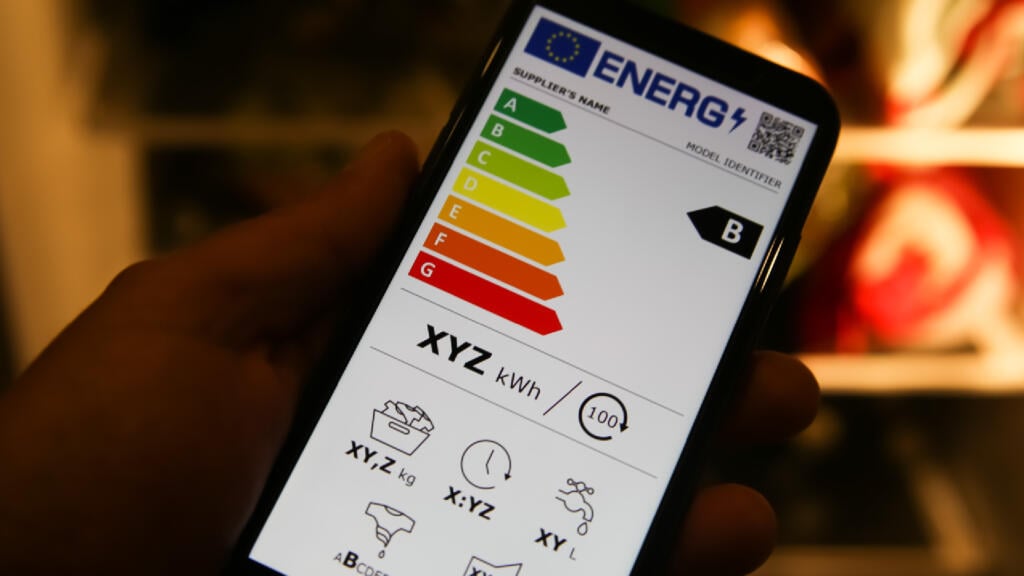
Energy saving tips that won’t break the bank
Sarah Harley
How to save energy and shop for the best appliance for your needs
We’ve all had it happen: a washing machine or fridge has suddenly stopped working – and it’s rarely with much notice.
When we use these appliances daily it’s often tempting to rush out and buy a replacement without much thought, as we’re focused about the aftermath of a load of wet washing or a stack of defrosted food.
But with the increase in energy prices and the need to be more sustainable to protect the future of our planet, it’s worth taking stock of the energy efficiency of appliances.
 Credit: Shutterstock/Ralf Liebhold
Credit: Shutterstock/Ralf LiebholdWe’ve all had it happen: a washing machine or fridge has suddenly stopped working – and it’s rarely with much notice.
When we use these appliances daily it’s often tempting to rush out and buy a replacement without much thought, as we’re focused about the aftermath of a load of wet washing or a stack of defrosted food.
But with the increase in energy prices and the need to be more sustainable to protect the future of our planet, it’s worth taking stock of the energy efficiency of appliances.
 Credit: Shutterstock/Ralf Liebhold
Credit: Shutterstock/Ralf LiebholdBy understanding the benefits and features they offer, you’ll be able to make the right choice for you and save some money to boot.
If you’re looking to save money on an appliance, buying a washing machine that’s in a sale may look appealing, but it might not be the bargain it first appears.
Think beyond the price tag and, instead, consider the running cost of the appliance over its lifetime.
According to kitchen company Magnet the lifetime of a washing machine and fridge freezer is a decade, while you can expect a tumble dryer to last 13 years, meaning small savings through efficiency each month will really stack up over time if you choose a more energy-efficient model.
 Credit: Shutterstock/Ground Picture
Credit: Shutterstock/Ground PictureComparing the running costs of different appliances will help you become aware of which appliances eat more energy. This gives you power in your decision making to put these on your priority list when choosing an efficient appliance.
Unsurprisingly, the good old tumble dryer is the most expensive kitchen appliance to run per hour, drawing the most energy, with ovens and kettles next on the list (according to the Magnet survey).
Fridges and freezers come at the bottom in terms of energy consumption but do bear in mind that these are switched on constantly, so their cost will be higher than smaller-use items.
According to Confused.com if you opt for a D-rated fridge freezer you can expect to pay £11.56 a month, while a vacuum cleaner will cost £1.36.
It can be easy to get enticed by the ‘wow factor’ of an appliance. Free-standing fridge freezers are one example that can make a real statement within your kitchen.
They’re perfect for when you have a full house and lots of mouths to feed, but if you’re only catering for one or two , it’s unlikely you’ll need that amount of storage space. If you’re running an appliance that’s half empty, you’ll be wasting energy.
As a guide, when buying a fridge for two people, look for a capacity of 100-150 litres. This increases to 150-200 litres for a household of three or four, and to over 250 litres for larger families.
The capacity you’ll need changes slightly for a freezer depending on whether you batch cook and therefore require additional storage space – if you do, then add around 25-50 litres of space.
As a benchmark, look for a capacity of 50 litres for individuals or couples, while 100 litres would suit a small family.
 Credit: Shutterstock/New Africa
Credit: Shutterstock/New AfricaNow you’ve realised the benefits of energy-saving appliances, and have worked out what sort of size you need, it’s time to start choosing an energy-efficient model.
All appliances must carry an energy-efficiency label, but you may have noticed energy labels on new products look different to ones on older appliances. This is because a new EU energy label was introduced in 2021 to cover the increased demand for greener and more efficient products.
The old label that ranged from A+++ to G has been revised to make it easy for consumers to understand and it’s now based on a simpler A-G grade.
This system is stricter than before, and fewer appliances will achieve the top ‘A’ rating, leaving room for more efficient appliances to be introduced in the future.
If you’re looking for an appliance today, Brian Horne, Senior Insight and Analytics Consultant at Energy Saving Trust advises, “Don’t be put off if you can’t find any A-rated products. It may be that the best you can get right now is a D, E or even F-rating.
“It could be a few years before manufacturers come up with new, even more efficient appliances that qualify for an A-rating.”
There are a few other features on the label too. You’ll be able to compare the energy consumption between appliances more easily, as the kWh rating (the amount of energy consumed per hour by the appliance) that sits below the coloured scale, is more prominent.
“You can use this number to compare with another product of a different size to see which one would be cheaper to run,” adds Horne.
You can also keep your eye out for a few new icons that have been added to the label, including the spinning efficiency of a washing machine. And for those consumers who are hungry for information, the label includes a QR code. You can simply scan this with your smart phone for up-to-date product information.
Apart from checking the energy efficiency label it’s worth buying a product with eco-saving features.
Does that dishwasher or washing machine you’re interested in have an eco-wash programme, and how much water does it use?
Eco modes work by reducing the wash and rinse temperatures meaning that less energy is spent on heating the water. According to Currys a low temperature wash can use between 35%-59% less energy than a standard hot cycle.
The Association of Manufacturers of Domestic Appliances (AMDEA) estimate using the eco-button on your washing machine and dishwasher can save you £90 a year and could reduce you bills by around 20%.
And if you choose an appliance that consumes less water per cycle and you have a water meter, you’ll be saving on that bill too.
Whether you have an outside space for drying clothes or live in a flat or apartment, there’s always a few months in the year when you’ll be relying on a tumble dryer.
Look out for those that have sensors to indicate when your clothes are dry like the Bosch Series 4, as this will avoid running the appliance for longer than is needed.
 Credit: Shutterstock/Monkey Business Images
Credit: Shutterstock/Monkey Business ImagesThere’s always the option to rethink what appliances you use. Could you swap your energy hungry tumble dryer for a dehumidifier that removes moisture from wet clothes?
How about reducing the amount you use your oven in exchange for a microwave, which saves energy by heating the food rather than the surrounding space?
Consider your home tech and how you use it. According to the Energy Saving Trust, laptops use 65% less electricity over a year than a desktop PC, while tablets use 70% less power than laptops. Apart from being more portable around the home, a laptop or tablet might be the energy-efficient device that fits the bill.
One thing we all enjoy is a good brew. Eco kettles are one appliance where we can all make a small change to be more sustainable. They’re designed to give you greater control over how much water you boil and have a hidden element to prevent the build-up of limescale, which reduces the efficiency of heating the water.
It’s certainly worth thinking outside the box and replacing your previous product with an alternative if it can still complete the task in hand.
Top energy saving tip
Now you’ve got the heads-up on what to look out for when buying an energy-efficient home appliance, why not look up from where you are right now and see how many appliances are on unnecessarily when they could be flipped off at the wall.

Written by Camilla Sharman she/her
Published: Updated:
With her 30 years of experience, Camilla Sharman has covered a wide range of sectors within the business and consumer industries both as a feature, content, and freelance writer. As a business journalist, Camilla has researched articles for many different sectors from the jewellery industry to finance and tech, charities, and the arts. Whatever she’s covered, she enjoys delving deep and learning the ins and out of different topics, then conveying her research within engaging content that informs the reader.